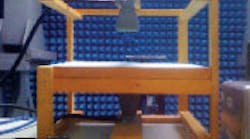All materials on Earth can be considered dielectric materials. Such materials can both influence and be influenced by the electric portion of an electromagnetic (EM) field. In a new "Tech Note," Emerson & Cuming Microwave Products provides a nice overview of simple dielectric materials, which have low conductivity and no semiconducting properties. The 11-page document begins with dielectric theory and wraps up with a summary of dielectric test methods.
The section on the "molecular basis of dielectrics," for example, explains that a dielectric material becomes polarized because it contains charge carriers that can be displaced. Such polarization can take four formsthree of which comprise charge carriers bound to atoms while the fourth consists of free electrons with restricted motion. The paper notes, however, that desirable low-loss dielectrics minimize free electrons. In such materials, an EM wave will be able to propagate with minimal attenuation.
A dielectric will reduce an EM wave's wavelength by a factor that is proportional to the square root of the dielectric constant. This factor is used to reduce the physical size of components. In circuit-board or patch-antenna applications, for example, a substrate with high relative dielectric constant allows the designer to reduce the overall size of the circuit due to the reduction in wavelength. Because of higher dielectric storing energy, however, bandwidth or efficiency may be reduced in the process. A material with high dielectric constant also can substantially reduce the size of a resonator.
To explain the potential of dielectrics, the document provides an in-depth look at dielectric theory, introducing and explaining equations related to wave propagation and the reflection and transmission of waves at a dielectric boundary. Overviews also are provided for artificial dielectrics, resonator concepts, low- to high-K materials, and more. In summary, this excellent document clearly presents a great deal of knowledge on a very complex topic.
Emerson & Cuming Microwave Products, Inc., 28 York Ave., Randolph, MA 02368; (781) 961-9600, FAX: (781) 961-2845, www.eccosorb.com.

